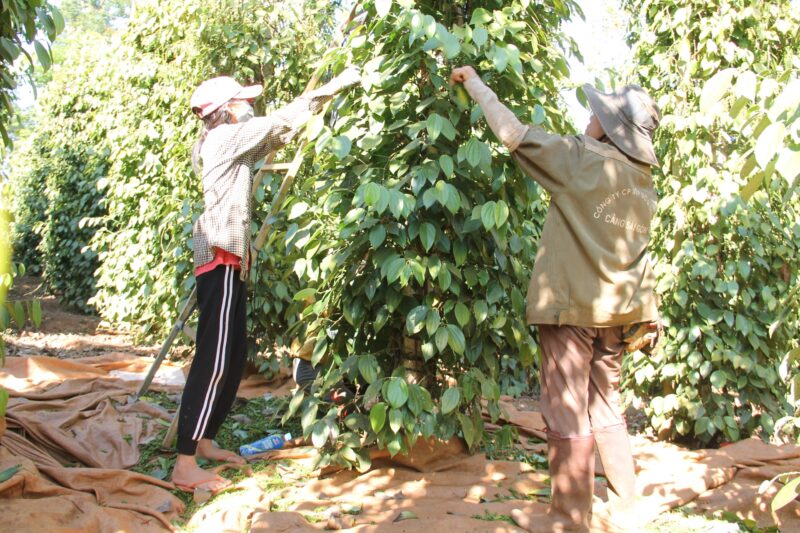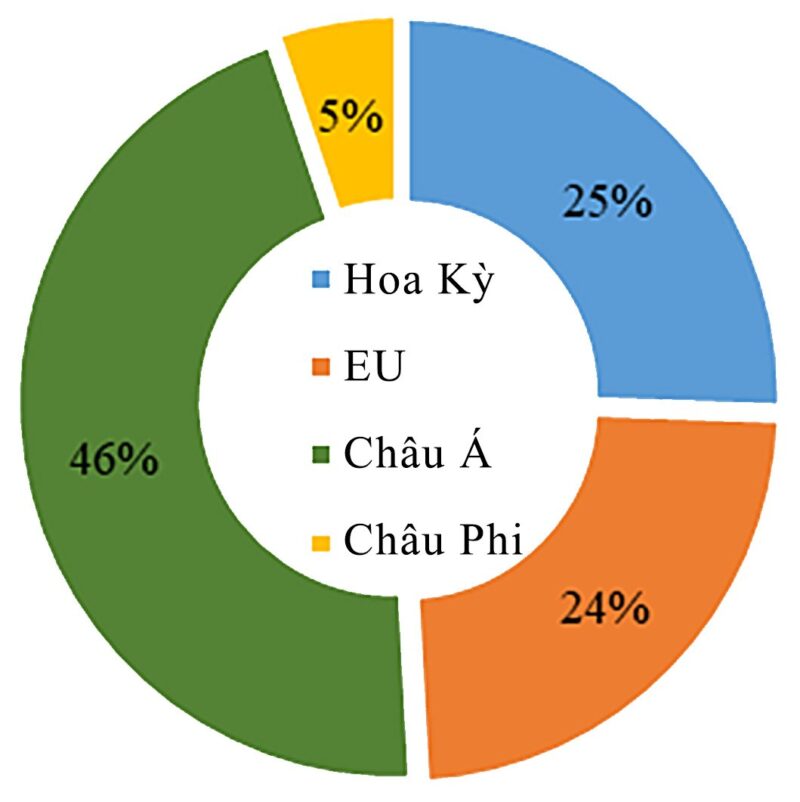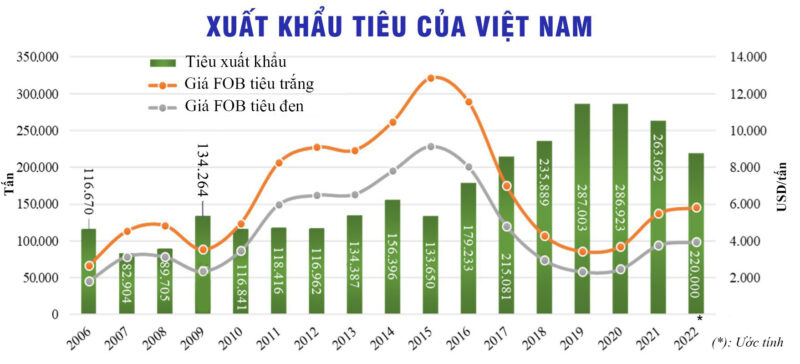Vietnam is the largest pepper producer and exporter in the world. However, the situation of pepper production in recent years has faced many difficulties due to the deep fall in prices and the increasing damage caused by diseases affecting the sustainable development of this industry.

Facing many challenges
Vietnam’s pepper is grown mainly in the Central Highlands and the Southeast, accounting for more than 93.5% of the country’s pepper area, of which the Central Highlands accounts for 64%. The pepper area has exceeded the planning by about 100,000 hectares (the national pepper area plan by 2020 is 50,000 hectares).
However, at present, the area of this crop tends to decrease to about 130,000 hectares by 2022 due to the sharp drop in prices and the impact of weather and diseases.
Dak Lak currently has over 32,800 hectares of pepper, the output is nearly 82,000 tons, accounting for about 40% of the area and 43.3% of the output of the whole Central Highlands.
From 2018 to now, the area of Dak Lak pepper has decreased significantly, about 5,000 hectares. In addition to the low price that causes people to cut down to plant other trees of higher economic value or intercrop in pepper gardens, the disease caused more than 2,000 hectares of pepper to die due to fast and slow death.

According to the Department of Agriculture and Rural Development, during the high price of pepper, people have massively planted it, even in unsuitable areas such as low-lying, low-lying areas and high groundwater levels.
Meanwhile, pepper growers apply unreasonable farming methods and lack of techniques, which has led to the frequent appearance of many types of pests and diseases, especially some particularly dangerous objects such as diseases. die fast, die slow…
In addition, in the years when pepper prices were low, people did not pay attention to invest in and apply disease management processes in orchards, which also led to the current mass death.
Agricultural experts said that although there are not too many harmful pests and diseases on pepper plants, there are some diseases that seriously affect the yield and quality of pepper, even causing plant death such as death disease. caused by the fungus Phytophthora, slow death caused by nematodes, some soil fungi and mealybugs. These are the most dangerous pests, often threatening, causing great damage to pepper production.
However, it is worth mentioning that there are many other types of pests that do not cause serious harm, but farmers still spray insecticides. Focusing only on pest control has increased the variety and quantity of pesticides on pepper plants and increased the risk of pesticide residues on exported pepper. This has led to the fact that importing countries have also increased the inspection of pesticide residues on Vietnamese pepper, making it difficult for exports and plummeting pepper prices.
In fact, in the past time, many export pepper shipments have been destroyed or returned, causing great damage to exporters, creating fear for pepper importers from Vietnam. This is also one of the main reasons affecting the sustainable development of the pepper industry
Towards the development of a sustainable product chain
Over the past decade, Vietnam’s pepper industry has experienced a period of ups and downs when the selling price peaked at nearly VND 230,000/kg, at other times the price dropped to VND 34,000/kg and now, the price of pepper has reached a peak of nearly VND 230,000/kg. consumption at 60,000 VND/kg. However, Vietnam is still the largest pepper producer and exporter in the world. In 2022, Vietnam’s exports are estimated at 220,000 tons, accounting for 55% of the total pepper production worldwide.
Vietnamese pepper has been exported to 115 countries and territories. Vietnam continues to be the world’s leading country in pepper production and export, accounting for over 40% on average in output and over 60% in the world’s pepper export market share. Particularly in Dak Lak province, in the 9 months of 2022, 24,496 tons of pepper have been exported, with an export turnover of 118 million USD to more than 30 markets around the world.
However, besides the achieved results, the pepper industry of the country in general and of Dak Lak in particular still has many challenges. That is, unpredictable climate change and pest problems; The increasingly strict regulations of important markets also lead to trade barriers… Therefore, in order for Vietnam’s pepper products in general and Dak Lak in particular to affirm its position in the world market. In a sustainable way, the pepper industry needs to increase its ability to conform to international standards, especially in aspects such as chemical residues, economic, social and environmental sustainable production criteria. .
According to the Department of Agriculture and Rural Development, for sustainable development, Dak Lak has also established specialized pepper cultivation areas. Scientific and technical advances have been gradually applied, such as: organic pepper production, economical application of irrigation technology, rational use of fertilizers, etc., gradually bringing pepper production towards sustainability, Environmental friendliness. In particular, the project “Promoting sustainable production and trade of Vietnamese pepper” is implemented in the period of 2021 – 2023 co-implemented by IDH, the European Spice Association and the Vietnam Pepper Association at three locations. Central Highlands provinces (Dak Lak, Dak Nong, Gia Lai) for about 10,000 farmers have contributed to capacity building in the pepper supply chain to meet the requirements of the European and US markets. At the same time, control and monitor agrochemicals in the pepper supply chain; increasing market access for small and medium-sized sustainable pepper producers; promote the adoption of sustainable farming practices; increase supply of pepper to meet market requirements.

Ms. Hoang Thi Lien, President of the Vietnam Pepper Association, said that in order to ensure the value of the pepper industry and develop sustainably, close cooperation is always needed between exporters, processors and producers. . At the same time, farmers must be placed at the center and farmers need to improve their farming knowledge. In addition, it is necessary to cooperate with businesses in the pepper industry, specifically, it is necessary to encourage businesses to cooperate closely or associate with cooperatives and farmers.
